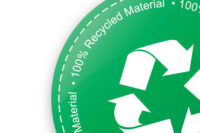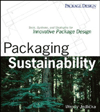Consortium reviews potential solution for PET plastic recycle stream issues
Full-wrap label consortium looks into positive results from trial run delabeling

In a continued effort to generate and test solutions to the recycling stream issues surrounding full-wrap labels on polyethylene terephthalate (PET) bottles, during its August 2013 meeting, the consortium toured a recycling facility and reviewed test results from a trial run using delabeling equipment. The test runs showed positive results, as the majority of labels were cleanly removed and the bottles sustained almost no damage, helping keep the recycling stream free of labels and maximizing yield.
The full-wrap label consortium, organized by Eastman Chemical Company (eastman.com), is dedicated to solving current recycling stream issues, including identifying PET containers with full-wrap labels, removing those labels, separating label material from PET and developing non-bleeding ink. At each of the consortium’s meetings since its formation more than a year ago, a growing number of members have continued to assess solutions to best solve current issues.
Top solutions
Delabeling equipment is one of the top near- and long-term solutions the consortium members think has among the highest potential to solve the recycling stream issues. During the recent trial run, an intact bale was fed through the entire bottle recycling system, including delabaling, whole bottle wash and delabeling. This trial showed that up to 97% of labels with perforation were removed.
“There is a great amount of dedication to improving and creating new delabeling equipment that can work with multiple systems and with greater degrees of efficiencies than what previously was available,” says Holli Whitt, market development manager, sustainability for specialty plastics, Eastman. “The consortium has opened opportunities for collaboration among groups that were already independently working toward similar goals.”
Growing interest
The consortium — which has met five times since August 2012 — includes more than 100 representatives from approximately 50 companies, which is double the number of participants since the first meeting. Membership includes a wide range of representatives across the value chain, including major brands, consumer goods manufacturers, resin producers, film extruders, print converters and label producers, equipment manufacturers, bottlers and packagers, plastics recyclers and independent testing firms.
At the August 2013 consortium meeting, numerous attendees noted the innovative thinking the group is putting toward solution development. There were comments that the consortium has helped educate the value chain about the challenges in recycling PET containers with shrink labels and that the group should serve as a model for how to solve complex recycling issues.
In addition, the consortium has been contacted by additional equipment manufacturers to help work toward potential solutions.
“Through discussions with members of the value chain during the consortium meetings, we’ve gained a better understanding of potential innovative solutions, including perforations and near infrared capabilities, as well as new equipment options available to the market,” Whitt says.
The next full-wrap label consortium meeting is in December. Before the end of the year, the group plans to obtain formalized organization recognition.
In a continued effort to generate and test solutions to the recycling stream issues surrounding full-wrap labels on polyethylene terephthalate (PET) bottles, during its August 2013 meeting, the consortium toured a recycling facility and reviewed test results from a trial run using delabeling equipment. The test runs showed positive results, as the majority of labels were cleanly removed and the bottles sustained almost no damage, helping keep the recycling stream free of labels and maximizing yield.
The full-wrap label consortium, organized by Eastman Chemical Company (eastman.com), is dedicated to solving current recycling stream issues, including identifying PET containers with full-wrap labels, removing those labels, separating label material from PET and developing non-bleeding ink. At each of the consortium’s meetings since its formation more than a year ago, a growing number of members have continued to assess solutions to best solve current issues.
Top solutions
Delabeling equipment is one of the top near- and long-term solutions the consortium members think has among the highest potential to solve the recycling stream issues. During the recent trial run, an intact bale was fed through the entire bottle recycling system, including delabaling, whole bottle wash and delabeling. This trial showed that up to 97% of labels with perforation were removed.
“There is a great amount of dedication to improving and creating new delabeling equipment that can work with multiple systems and with greater degrees of efficiencies than what previously was available,” says Holli Whitt, market development manager, sustainability for specialty plastics, Eastman. “The consortium has opened opportunities for collaboration among groups that were already independently working toward similar goals.”
Growing interest
The consortium — which has met five times since August 2012 — includes more than 100 representatives from approximately 50 companies, which is double the number of participants since the first meeting. Membership includes a wide range of representatives across the value chain, including major brands, consumer goods manufacturers, resin producers, film extruders, print converters and label producers, equipment manufacturers, bottlers and packagers, plastics recyclers and independent testing firms.
At the August 2013 consortium meeting, numerous attendees noted the innovative thinking the group is putting toward solution development. There were comments that the consortium has helped educate the value chain about the challenges in recycling PET containers with shrink labels and that the group should serve as a model for how to solve complex recycling issues.
In addition, the consortium has been contacted by additional equipment manufacturers to help work toward potential solutions.
“Through discussions with members of the value chain during the consortium meetings, we’ve gained a better understanding of potential innovative solutions, including perforations and near infrared capabilities, as well as new equipment options available to the market,” Whitt says.
The next full-wrap label consortium meeting is in December. Before the end of the year, the group plans to obtain formalized organization recognition.
Looking for a reprint of this article?
From high-res PDFs to custom plaques, order your copy today!









